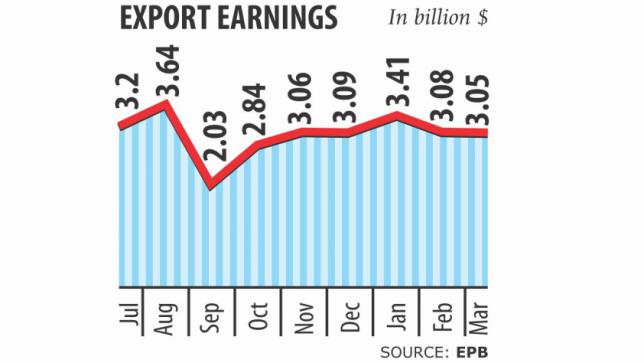Published in The Daily Star on April 04, 2018

Export earnings fell 1.38 percent year-on-year to $3.05 billion in March due to a decline in leather goods shipment.
March’s receipts fell short of the $3.16 billion target for the month, according to data from the Export Promotion Bureau (EPB).
Leather and leather goods sector—the second largest export earner after garments—fetched $848.78 million in the July-March period, down 8.04 percent year-on-year.
The shipment of leather and leather goods went down largely as the relocation of tanneries from Hazaribagh to Savar has hampered production of such goods.
All the tanneries have been relocated, but only 25 out of 155 have so far started production in their new location, industry people said.
Garments exports grew 9.11 percent year-on-year to $22.83 billion in July-March. Knitwear exports rose 11.61 percent to $11.32 billion and woven garments exports increased 6.75 percent to $11.51 billion during the period.
Garment shipment, which account for more than 80 percent of the national export, grew because of the increased sales of high-value items and the depreciation of the local currency against the US dollar.
“The higher exchange rate of the US dollar helped exports a bit,” said Siddiqur Rahman, president of Bangladesh Garment Manufacturers and Exporters Association.
The exchange rate rose to Tk 84 a dollar, up from Tk 78 and Tk 80 previously.
Rahman said garment exports would grow by 10 percent at the end of the current fiscal year as the market trend is favourable for Bangladesh.
Thanks to the significant improvement of the structural, fire and electrical safety in garment factories, western retailers and brands are coming with bulk orders, he said.
Nearly 90 percent remediation work in the garment factories has already been completed, which has brightened the image of the sector.
Bangladesh is also home to the highest number of green garment factories in the world, according to Rahman.
Moreover, the country is moving towards high-value items from basic garments. As a result, exporters are getting better prices, he said.
Jute and jute goods also fared well in July-March thanks to the diversification in the sector.
The demand for jute goods from Bangladesh is rising as customers are gradually giving up the use of harmful polythene globally. In July-March, jute and jute goods fetched $818.09 million, up 11.91 percent year-on-year, EPB data showed.
Jute production surged from 65 lakh bales in 2014 to 70 lakh bales last year for better prices ensured by a government rule that made its use mandatory in goods packaging, according to the jute ministry.
More than 100 crore sacks were additionally produced thanks to the new rule.
Local entrepreneurs also expanded the export base by increasing the number of products made from the natural fibre to 240 this year from 135 last year.
Overall, exports grew 6.33 percent year-on-year to $27.45 billion in July-March period. It, however, narrowly missed the periodic target of $27.55 billion.
Shipment of agricultural products grew 15.46 percent year-on-year to $472.23 million, while frozen food exports were up 6.57 percent to $407.71 million.
Home textile export surged 15.08 percent to $669.87 million and footwear shipment rose 5.84 percent to $187.09 million.
Exports of plastic goods fell 19.49 percent to $73.59 million in the July-March period.
 CPD RMG Study Stitching a better future for Bangladesh
CPD RMG Study Stitching a better future for Bangladesh



